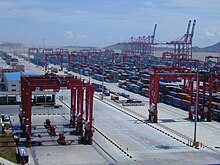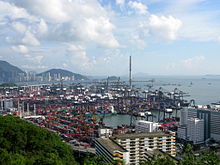21st Century Maritime Silk Road

The21st Century Maritime Silk Road(Chinese:21 thế kỷ hải thượng ti trù chi lộ), commonly justMaritime Silk Road(MSR), is the sea route part of theBelt and Road Initiativewhich is[1]a Chinese strategic initiative to increase investment and foster collaboration across the historicSilk Road.[2][3][4]
The maritime silk road essentially runs from the Chinese coast to the south viaHanoitoJakarta,SingaporeandKuala Lumpurthrough theStrait of Malaccathen viaColomboin Sri Lanka towards the southern tip ofIndiaviaMalé,to the East AfricanMombasa,from there toDjibouti,then through the Red Sea via theSuez Canalto the Mediterranean, then viaHaifa,IstanbulandAthensto the Upper Adriatic region to the northern Italian hub ofTriestewith its international free port and its rail connections toCentral Europeand theNorth Sea.
TheChina–Pakistan Economic Corridoris an extension of the proposed Silk Road. The Maritime Silk Road coincides with the theory of China'sString of Pearlsstrategy.
History[edit]
The Maritime Silk Road initiative was first proposed byChinese leaderXi Jinpingduring a speech to theIndonesian Parliamentin October 2013.[5]
In November 2014, Chinese leader Xi Jinping announced plans to create aUSD$40 billion development fund, which would help finance China's plans to develop the New Silk Road and the Maritime Silk Road. China has accelerated its drive to draw Africa into the MSR with the speedy construction of a modern standard-gauge rail link between Nairobi and Mombasa.[6]
In March 2015, theNational Development and Reform Commissionof China publicly released a document titledVision and Actions on Jointly Building Silk Road Economic Belt and 21st-Century Maritime Silk Road,[7]which discusses the principles and framework which form the foundation of the initiative.
Routes and key ports[edit]
Although the routes encompassed in the MSR will be copious if the initiative comes to fruition, to date there has not been ample official information released concerning specific ports.
Between 2015 and 2022, China has leased ownership over the following ports:[8]
- Gwadar,Pakistan:40 years
- Kyaukpyu,Myanmar:50 years
- Kuantan,Malaysia:60 years
- Obock,Djibouti:10 years
- Malacca Gateway:99 Years
- Hambantota,Sri Lanka:99 years
- Muara,Brunei:60 years
- Feydhoo Finolhu,Maldives:50 years
- Port Darwin,Australia:99 years
- Newcastle Port,Australia:98 years
In the 2018Xinhua-Baltic International Shipping Centre Development Index Report,[9]the China Economic Information Service cites the following as major routes for the 21st Century Maritime Silk Road:
China – Southeast Asia route[edit]

China – Vietnam, Myanmar[edit]
Qinzhou–Yangpu–Zhanjiang–GaolanPort –Yantian–Nansha–Ho Chi Minh City(Vietnam) –Singapore–Yangon(Myanmar) –Palawan(Philippines) – Singapore – Qinzhou.
China – Philippines[edit]
Qingdao–Shanghai–Ningbo–Manila(South) – Manila (North) – Qingdao.
Singapore and Malaysia[edit]

Newport –Dalian– Qingdao – Shanghai –Xiamen–Hong Kong– Singapore –KlangPort (Malaysia) –Penang(Malaysia) – Singapore – Hong Kong –Xingang.
Indonesia[edit]
Shanghai – Newport – Dalian – Qingdao – Ningbo – Nansha –Jakarta(Indonesia) – Klang Port (Malaysia) – Singapore –Laem ChabangPort (Thailand) – Hong Kong – Shanghai.
China – Thailand, Cambodia[edit]
Ningbo – Shanghai –Shekou–Sihanoukville(Cambodia) –Bangkok– Leam Chabang (Thailand) – Ningbo.
China – South Asia route[edit]
China – Pakistan[edit]
Qingdao – Shanghai – Ningbo – Singapore – Klang Port (Malaysia) –Karachi(Pakistan) –Mundra(India) –Colombo(Sri Lanka) – Singapore – Qingdao.
India, Sri Lanka[edit]
Shanghai – Ningbo – Shekou – Singapore – Port Klang (Malaysia) – Kolkata (India) –Pipavav(India) – Colombo (Sri Lanka) – Port Klang – Singapore – Ho Chi Minh City (Vietnam) – Hong Kong – Shanghai.
Middle East, East Africa route[edit]
China – Iraq, UAE[edit]
Shanghai – Ningbo –Kaohsiung–Xiamen– Shekou – Port Klang (Malaysia) – Alishan Port (UAE) –Umm Qasr(Iraq) – Port Klang – Kaohsiung – Shanghai.
China – Red Sea[edit]
Shanghai – Ningbo – Xiamen – Chiwan – Singapore – Djibouti (East Africa) –Jeddah(Saudi Arabia) –Sudan(Sudan) – Djibouti – Port Klang – Shanghai.
Europe route[edit]

The MSR route to Europe will begin in China, pass through theMalacca Strait,followRed Seathrough theSuez Canalto theMediterranean Sea,and visit ports in Greece, Italy, France, and Spain before returning to China. The Maritime Silk Road has also an important role in the connection betweenEast Africaand theMediterranean regionthrough the Suez Canal. Of particular interest to China is the port of Piraeus in Athens, Greece, whichChinese PremierLi Keqiangstated "...can become China's gateway to Europe. It is the pearl of the Mediterranean." China is investing heavily in Athens in the port and infrastructure.[10][11]
The Chinese Silk Road Initiative then led Europe to consider adapting the infrastructure to changing conditions. In recent years there have been major investments from Italy, the EU, Germany and Hungary to developTriestewith its rail connections toCentralandEastern Europeas a central European hub of the Maritime Silk Road. This also applies to the partial relocation of the flow of goods from the northern ports to the Mediterranean.[12][13][14][15][16][17]


There are extensive intra-European infrastructure projects in place to adapt trade flows to current needs. This applies, for example, to the expansion of the Belgrade-Budapest railway line, the Brenner Base Tunnel and the connections on the Adriatic-Baltic and Adriatic-North Sea axes. With regard to costs and environmental protection, in contrast to longerEast Asiantraffic via northwest Europe, the sea route through theSuez Canalto the Adriatic bridgehead of Trieste with its free trade zone shortens the transport of goods to Central and Eastern Europe by at least four days.[18][19]
Experimental attempts are also being made to organize the movement of goods from China to Europe via the Northeast Passage through the polar sea. There is already resistance from environmental protection organizations who fear significant interference in the sensitive ecosystems in the north.[20]
One of the most important ports in the Mediterranean isValencia,Spain. The port, in which many Chinese companies have settled, is to be provided with a free trade zone.[21]
Qingdao–Shanghai–Ningbo–Kaohsiung–Hong Kong–Yantian–Singapore–Piraeus(Greece) –Trieste(Italy) –La Spezia(Italy) –Genoa(Italy) –Fos-sur-Mer(France) –Valencia(Spain) –Piraeus(Greece) –Jeddah(Saudi Arabia) –Colombo(Sri Lanka) –Singapore–Hong Kong
Challenges[edit]
There exist a number of unresolvedterritorial disputes in the South China Seabetween China andASEANcountries such as Brunei, Malaysia, Indonesia, the Philippines, and Vietnam.[8]Potential routes proposed for the MSR could contribute to increasing tensions over certain areas. However, some academics propose that the MSR initiative will provide a means for China to resolve these sovereignty-related conflicts by providing an opportunity for mutual gain.[22]
It has been suggested that the future of the MSR will be largely dictated by the economic conditions of the participating countries.[23]The possibility exists that China may have to make financial contributions to other MSR countries who are experiencing poor economic conditions. China will need to ensure that any loans allocated to these countries are spent appropriately.[24]
Coordination on the national and subnational levels may be challenging for China. It has been stated that China's subnational actors – such asmultinational corporations,provinces,cities, and towns – have a tendency to strongly prioritize their own interests above those of the nation and participate in government initiatives primarily to satisfy their own objectives. This could lead to inappropriate spending on projects outside the scope of China's national interests.[25]
Gaining political approval from countries with different political systems could prove problematic for China. Countries may be wary about joining the MSR initiative due to geopolitical and security factors.[26]
Concerns have been put forth regarding whether China will be able to receive India's cooperation and participating in bringing the initiative to fruition.[27][28][23]India represents a strong economic force and may likely prefer to develop the Indian Ocean region's infrastructure itself rather than allow China to have any control over the region.[27]While Chinese investment in India's underdeveloped maritime infrastructure could benefit India's economy greatly, India remains wary to accept such investment as the possibility exists that China is primarily attempting to expand its own territorial and economic interests.[29]India has also expressed circumspection in participating in a similar initiative, the Bangladesh – China – India – Myanmar economic corridor.[23]
See also[edit]
- Asia-Africa Growth Corridor
- Container transport
- Foreign policy of China
- Golden Banana
- Indo-Pacific
- International North–South Transport Corridor
- List of ports and harbours of the Indian Ocean
- List of the largest trading partners of China
- List of world's busiest container ports
- Maritime Jade Road
- Maritime Silk Road
- Maritime Silk Road Museum
- New Suez Canal
- Suez Canal
References[edit]
- ^Kuo, Lily; Kommenda, Niko."What is China's Belt and Road Initiative?".the Guardian.Retrieved2019-04-02.
- ^"Sri Lanka Supports China's Initiative of a 21st Century Maritime Silk Route".2015-05-11. Archived fromthe originalon 2015-05-11.Retrieved2019-04-02.
- ^Tiezzi, Shannon."China Pushes 'Maritime Silk Road' in South, Southeast Asia".The Diplomat.Retrieved2019-04-02.
- ^"Reflections on Maritime Partnership: Building the 21st Century Maritime Silk Road_China Institute of International Studies".www.ciis.org.cn.Archived fromthe originalon 2015-04-03.Retrieved2019-04-02.
- ^"Full text of President Xi's speech at opening of Belt and Road forum".www.fmprc.gov.cn.Retrieved2019-04-02.
- ^Page, Jeremy (2014-11-08)."China to Contribute $40 Billion to Silk Road Fund".Wall Street Journal.ISSN0099-9660.Retrieved2019-04-02.
- ^"Vision and Actions on Jointly Building Silk Road Economic Belt and 21st-Century Maritime Silk Road".National Development and Reform Commission (NRDC) People's Republic of China.28 March 2015. Archived fromthe originalon 27 November 2018.Retrieved3 April2019.
- ^ab"THE 21ST CENTURY MARITIME SILK ROAD: Security implications and ways forward for the European Union"(PDF).sipri.org.30 March 2019.
- ^"Xinhua-Baltic 2018 International Shipping Centre Development Index Report"(PDF).safety4sea.com.29 March 2019.
- ^Chaziza, Mordechai (2018). "The Chinese Maritime Silk Road Initiative".Mediterranean Quarterly.29(2): 54–69.doi:10.1215/10474552-6898099.S2CID158529092.
- ^Harry G. Broadman "Afrika´s Silk Road" (2007), pp 59.
- ^Marcus Hernig: Die Renaissance der Seidenstraße (2018) pp 112.
- ^Harry de Wilt: Is One Belt, One Road a China crisis for North Sea main ports? in World Cargo News, 17. December 2019.
- ^Linda Vierecke, Elisabetta Galla "Triest und die neue Seidenstraße" In: Deutsche Welle, 8 December 2020.
- ^Bernhard Simon: Can The New Silk Road Compete With The Maritime Silk Road? in The Maritime Executive, 1 January 2020.
- ^"Trieste, ex Aquila venduta all'ungherese Adria Port" In: Il Piccolo, 18.12.2020
- ^"Hamburger Hafenkonzern investiert groß in Triest" In: Die Presse 29 September 2020; Thomas Fromm "Hanseatische Seidenstraße" In: Süddeutsche Zeitung 5 October 2020; "Logistica, il colosso Duisport acquisisce il 15% delle quote dell'Interporto di Trieste" In: Il Piccolo, 15 December 2020
- ^Gerald Pohl: Neue Seidenstraße: China drängt es nach Europa in: Die Presse 17. September 2019; Hafen Triest auf Wachstumskurs: Neue Bahnverbindung nach Rostock. In: Der Trend, 17. October 2018; Frank Behling: Hafenzug Kiel–Triest. Von der Förde ans Mittelmeer. In Kieler Nachrichten: 25. January 2017.
- ^Harry de Wilt: Is One Belt, One Road a China crisis for North Sea main ports? in World Cargo News, 17. December 2019.
- ^Birger Nicolai "Im Winter durchs Eismeer? Das geht und hat Vorteile" Die Welt 13.7.2018
- ^Anja Steinbuch, Jürgen Hoffmann "Was bringt Chinas Neue Seidenstraße?" In: Deutsche Welle 17.11.2017
- ^Hui-yi, Katherine Tseng (2016-06-16)."Re-contemplating the South China Sea Issue: Sailing with the Wind of the 21st Century Maritime Silk Road".The Chinese Journal of Global Governance.2(1): 63–95.doi:10.1163/23525207-12340016.ISSN2352-5207.
- ^abcBlanchard, J.-M. F. (2017). "Probing China's Twenty-First-Century Maritime Silk Road Initiative (MSRI): An Examination of MSRI Narratives".Geopolitics.22(2): 246–268.doi:10.1080/14650045.2016.1267147.S2CID152063288.
- ^Ibid.
- ^Ibid
- ^Ibid.
- ^abKnowledge, CKGSB."Mapping China's New Silk Road Initiative".Forbes.Retrieved2019-04-03.
- ^J. Yang, ‘Making the Maritime Silk Road a New Promoter of Cooperative Interaction between China and South Asia’, Keynote Speech given at the “Political Economy of China’s Maritime Silk Road and South Asia” conference, 21 Nov. 2015, Shanghai, China.
- ^Palit, Amitendu (2017-04-03). "India's Economic and Strategic Perceptions of China's Maritime Silk Road Initiative".Geopolitics.22(2): 292–309.doi:10.1080/14650045.2016.1274305.ISSN1465-0045.S2CID157911700.

